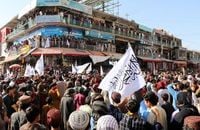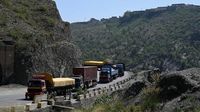Clashes along the volatile border between Pakistan and Afghanistan have erupted yet again, casting a long shadow over already fraught relations and raising fresh concerns about regional stability. The recent violence, which unfolded between October 13 and 15, 2025, marks one of the most intense escalations since the Taliban returned to power in Kabul in 2021, with both sides trading accusations, artillery fire, and diplomatic barbs.
According to the Associated Press, fighting broke out on Tuesday in a remote sector of Pakistan’s Khyber Pakhtunkhwa province. State-run media in Pakistan accused Afghan troops of opening “unprovoked fire,” a claim repeated by security officials who told reporters that Pakistani forces responded forcefully, damaging Afghan tanks and military posts. Pakistani military sources, quoted by PTV News and Dawn, described a “strong response” in the Kurram district, where not only were Taliban regime posts hit hard, but a tank was reportedly set ablaze, compelling Taliban fighters to retreat from their positions.
Afghan officials did not dispute that clashes had occurred. Tahir Ahrar, a deputy police spokesperson in Afghanistan’s Khost province, confirmed the fighting but declined to provide further details. The skirmishes mark the second such exchange in less than a week, highlighting the persistent volatility along the border that both countries share—a line that is both geographically daunting and politically contentious.
The violence is not confined to isolated firefights. Over the weekend preceding the latest clashes, Kabul claimed it had targeted several Pakistani military posts in retaliation for what it described as repeated violations of Afghan territory and airspace. The Afghan government said its forces killed 58 Pakistani soldiers. Pakistan, for its part, reported lower losses—23 soldiers killed—but insisted that its retaliatory fire resulted in the deaths of more than 200 “Taliban and affiliated terrorists.” The numbers differ, but the message from both sides is clear: neither is willing to back down.
Border crossings at Torkham and Chaman—the main arteries between the two countries—have remained sealed since the weekend’s violence, disrupting trade and the movement of people. The closures came after appeals from regional powers, including Saudi Arabia and Qatar, managed to secure a brief pause in hostilities, but not a lasting peace.
The roots of the conflict run deep. Islamabad has long accused Kabul of harboring the Tehreek-e-Taliban Pakistan (TTP), a militant group that has claimed responsibility for numerous deadly attacks inside Pakistan. The TTP, while organizationally distinct from the Afghan Taliban, shares ideological ties and, according to Pakistan, enjoys sanctuary across the border. In the past year alone, the TTP has been linked to at least 600 attacks against Pakistani security forces, according to data from the US-based Armed Conflict Location & Event Data (ACLED) project cited by Al Jazeera. The surge in violence since the Taliban’s 2021 takeover in Afghanistan has pushed Pakistan to adopt a more aggressive stance, including cross-border strikes targeting alleged militant hideouts.
For its part, the Taliban government in Kabul denies allowing its territory to be used for attacks against neighbors. It has repeatedly rejected Pakistani claims, asserting that it does not permit its soil to become a launching pad for foreign militants. Yet, the pattern of attacks and reprisals has only intensified suspicions and deepened mistrust.
The recent escalation has undone months of fragile diplomatic progress. Earlier in 2025, Pakistan’s foreign minister, Ishaq Dar, met his Taliban counterpart, Amir Khan Muttaqi, in Kabul. Subsequent meetings in May and August, brokered by China, had raised hopes for a reset in ties. But the deadly weekend of October 11-12, with dozens of soldiers killed on both sides and both governments claiming to have captured enemy posts, has put those diplomatic overtures on ice. Islamabad claimed to have seized 19 Afghan posts, while Kabul insisted it had captured 25 Pakistani ones—a grim tally that underscores the ferocity of the fighting.
Regional powers are watching closely. China, Iran, and Russia have all urged the Taliban to rein in armed groups operating from Afghan territory. At the Moscow Format consultation in early October, attended by Taliban foreign minister Muttaqi, the message was clear: unchecked militancy threatens not just Pakistan, but also the wider region.
Analysts cited by Al Jazeera believe that the crisis is unlikely to abate soon. Abdul Basit, a research fellow at Singapore’s S Rajaratnam School of International Studies, predicts more diplomacy in the coming days, possibly led by Gulf nations or China, but cautions that “tensions will continue to simmer, sometimes going up or sometimes going down. We certainly cannot rule out another round of hostilities at the border.”
Seema Ilahi Baloch, a former Pakistani ambassador involved in past talks with Afghanistan, emphasized the need for both sides to recognize the damage such conflicts inflict. “Both sides must realise that such conflicts undermine bilateral cooperation and negatively impact regional stability,” she said. Baloch also pointed to China’s unique position as a potential mediator, given its influence with both Islamabad and Kabul.
Pakistan’s internal situation adds another layer of urgency. The Centre for Research and Security Studies (CRSS), an Islamabad-based think tank, estimates that more than 2,400 Pakistani security personnel have died in the first three quarters of 2025 alone—a figure on track to make this the deadliest year in a decade. The rising toll is fueling calls within Pakistan’s policy circles for a tougher response, with some officials openly questioning the legitimacy of the Taliban government for the first time since its return to power. A statement from Pakistan’s Ministry of Foreign Affairs demanded “concrete and verifiable actions against these terrorist elements by the Taliban regime” and called for a more inclusive Afghan government.
The border violence also comes at a time of shifting regional alliances. The weekend’s clashes coincided with Afghan foreign minister Muttaqi’s landmark visit to India—the first by a senior Taliban leader since 2021. India, once a vocal critic of the Taliban, has begun a cautious diplomatic outreach, even as Islamabad accuses New Delhi of stirring unrest in Pakistan’s northwest and Balochistan provinces. India, for its part, denies these allegations, but the timing of Muttaqi’s visit has not gone unnoticed in Islamabad.
Some analysts see parallels between Pakistan’s current posture toward Afghanistan and India’s approach to Pakistan earlier this year, when New Delhi launched strikes inside Pakistani territory following an attack in Indian-administered Kashmir. Yet, as Abdul Basit notes, the military balance between Pakistan and Afghanistan is starkly different from that between India and Pakistan. While Pakistan has the capacity to respond robustly to Indian strikes, the Taliban lack the equipment and training to match Pakistan’s professional military.
For now, the immediate military escalation has subsided, but the underlying tensions remain unresolved. The border remains closed, diplomatic channels are frayed, and both countries are on high alert. As one analyst put it, “No country can afford a two-front war,” a warning that resonates as Pakistan navigates challenges on both its western and eastern borders. The coming weeks will reveal whether diplomacy or further violence will shape the next chapter in this complex and combustible relationship.


